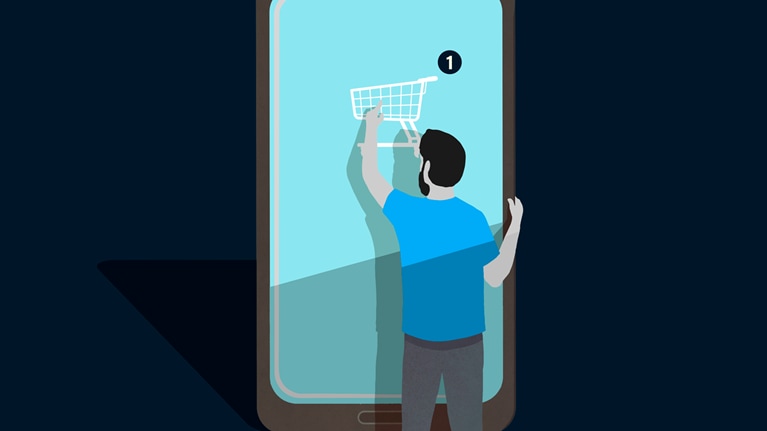
In 30 short years, e-commerce has revolutionized the way we shop. Shopping no longer refers only to going to a store, picking out and paying for goods, then bringing them home. Shopping trips that used to take hours can now take seconds and can be done from anywhere with an internet signal. The thrill of the purchase is now stretched out, starting with the customer’s initial product comparisons and culminating with the “unboxing” (which has become an industry in itself) and, maybe, writing an online review.
Get to know and directly engage with senior McKinsey experts on e-commerce
Aimee Kim is a senior partner emeritus in McKinsey’s Seoul office; Ari Libarikian and Marc Brodherson are senior partners in the New York office; Arun Arora is a senior partner in the Paris office; Kate Smaje, Ralf Dreischmeier, and Yuval Atsmon are senior partners in the London office; Julien Boudet is a senior partner in the Southern California office; Karel Dörner is a senior partner in the Munich office; Paul Roche is a senior partner in the Bay Area office; and Sajal Kohli is a senior partner in the Chicago office.
Simply put, e-commerce is anything—goods or services—bought or sold on the internet (see sidebar, “What are the different types of e-commerce?” for a description of e-commerce categories). E-commerce has been growing consistently ever since the first online transaction in 1994, when someone sold his friend a Sting CD for $12.48, plus shipping. But when the COVID-19 pandemic hit, triggering lockdowns all over the world, customers went all in: Year-over-year growth of e-commerce as a share of total retail sales grew 1.6 times in China, 3.3 times in the United States, and 4.5 times in the United Kingdom. E-commerce sales penetration in the United States more than doubled to about 35 percent in 2020 from about 16 percent the previous year, roughly the equivalent of ten years of growth. Globally, 20 percent of total global sales are made from online purchases.
Large retailers were the primary beneficiaries of this massive collective pivot to online purchasing, particularly those that had been investing in e-commerce infrastructure and capabilities for years. But for businesses accustomed to operating offline, incorporating e-commerce into the customer experience can be fraught with challenges. According to McKinsey analysis, small and medium-size retailers (those with less than $5 billion in annual revenue) and brand manufacturers, such as consumer-packaged-goods (CPG) and apparel companies, realize a much smaller portion of revenue from e-commerce than large retailers with years of experience in the e-commerce realm. For those that rushed to launch e-commerce services, cracks are already beginning to appear. But we’ve also seen that the e-commerce opportunity, particularly for small and medium-size enterprises (SMEs), is tremendous—especially in the era of gen AI.
Read on for a deep dive into e-commerce. We’ll start with how e-commerce can drive value for small and large retailers, then move on to how other types of organizations, including brands, CPG companies, and B2B companies, can build value via e-commerce. We’ll then explore the next generation of e-commerce—one in which emerging technologies are powering a more comprehensive and interconnected ecosystem than existed before. Finally, we’ll turn to how organizations in emerging markets are embracing e-commerce.
Learn more about our Growth, Marketing & Sales Practice.

Looking for direct answers to other complex questions?
What is social commerce?
Social commerce is when shoppers engage with brands, explore products, and make purchases on social media apps. It reflects a paradigm shift in how customers interact with brands; rather than navigating to a brand’s website (or, for that matter, visiting a store in person), customers are increasingly interacting with brands on social media apps. With social commerce, brands lean into these interactions, creating content that is less overtly promotional than traditional ads. This can include influencer marketing or sponsored content; whereas in the past you might have seen an ad for a new skin care product, today you are more likely to see a video of an influencer doing a skin care routine featuring a specific product, which you can then buy directly on the platform.
Social commerce first gained significant traction in China in 2021, when goods and services purchased through social commerce reached $352 billion—or 13 percent of total e-commerce. The United States market is catching up: Some estimates value the US social-commerce market at nearly $90 billion, up from $37 billion in 2021. Over the past few years, social and creator platforms, including Pinterest, TikTok, YouTube, Amazon, and others, have rolled out social- and live-commerce capabilities in the United States. By 2025, the global social-commerce market is expected to exceed $2 trillion.
What is live commerce?
Live commerce is a social-commerce format pioneered by Alibaba in 2016, which enables real-time product purchasing and interaction with a host during a live video event. Live commerce has become mainstream in China—in 2021, goods and services purchased through live-stream shopping in China totaled $132 billion—and is growing quickly in other markets including Europe and the United States. McKinsey research reveals that shoppers across regions use live commerce for very different reasons. In Europe and the United States, shoppers see live commerce as entertainment: 42 percent of shoppers in the United States and 38 percent in Europe say they engage with the format because it’s “fun.” In China, conversely, “fun” ranked last: Live-commerce users there are more likely to use the format for functional reasons, such as ease of shopping for their favorite brands or for better prices and deals.
Learn more about our Growth, Marketing & Sales Practice.
How do retailers of various sizes benefit from e-commerce?
E-commerce builds value for retailers of all sizes by driving efficient sales and creating alternative revenue streams, such as retail media networks.
Smaller retailers
Many small companies, in their rush to launch a new business, fall into traps that inhibit long-term growth. The stats for new-business survival are grim: Only 24 percent of new businesses launched in the past ten years have become viable large-scale enterprises.
Nascent e-commerce businesses face special challenges. McKinsey analysis has identified five short-term traps that hamper small and medium-size companies’ e-commerce growth, as well as ways to guard against them:
- Leading with tech focus while deferring investment in areas such as operations and channel management. To avoid inventory shortfalls, ensure that sales and operations leaders have the same success metrics as IT teams, and build all elements of the business in parallel.
- Building a directionless tech stack solely for a launch. The wrong tech architecture will create technical debt that hampers efforts to scale. To combat this, define the longer-term architecture and build a minimum viable product as a stepping stone to a larger goal.
- Underinvesting funds and capabilities. Companies are frequently tempted to spend as little as possible on launching e-commerce businesses—and then expect an immediate ROI for every dollar spent. To guard against this trap, build in a “learning buffer” to any budget to allow for necessary (and instructive) setbacks.
- Learning the economics on the fly, rather than taking time to fully understand unit economics and implement a business model with long-term potential. Instead, work to understand the key drivers of growth and profitability through the lens of profit and loss.
- Building the new business too close to the core. Corporate business-building activities are often hampered by internal policies that slow the development of a new business. Combat this by creating distance between the new e-commerce business and core businesses. This allows for more agile ways of working that reflect the nature of the new business.
Larger retailers
For larger retailers looking to get a piece of the e-commerce pie, time is of the essence. Generally, companies can create a working e-commerce site in less time than they think. In our experience, however, new businesses can be launched in fewer than four months.
A European retail chain with about 1,000 brick-and-mortar retail stores around the world decided to create an e-commerce presence. Thirteen weeks later, it had a fully functioning e-commerce business in one of its regions. The launch was successful from the first month, generating nearly 3 percent revenue growth in the region, tripling average basket size compared with retail stores, and maintaining high customer satisfaction. Here are three main lessons from that company’s program:
- Be pragmatic. Rather than attempting to launch a full-blown digital business across all markets at once, the retail CEO decided to go to market fast, in one region, with a limited offering. All initiatives that didn’t have direct customer impact were postponed in favor of efforts that did.
- Assign ownership, not tasks. By clearly designating which teams were responsible for which tasks, the retail chain was able to launch at speed. The chain created four teams in charge of the launch: tech and design, operations, product assortment, and marketing.
- Learn and adapt. Putting in place the right KPIs early in the process of launching an e-commerce business is critically important, since the KPIs allow companies to track what’s happening and adapt to drive continual improvement.
Learn more about McKinsey Digital.
How can e-commerce drive value for brands?
One way brands can build value is via direct-to-consumer (D2C or DTC) e-commerce. There are distinct advantages for retailers establishing direct relationships with end consumers. Here are some examples of brands that successfully used DTC e-commerce:
- Harry’s, a men’s grooming-product company, used DTC to generate customer insights and build community. A prelaunch campaign helped the company gather 100,000 email addresses from potential customers through a waitlist and social sharing. Harry’s also learned from its interactions with early customers and tweaked its products before releasing them more widely.
- Lego.com has excelled at brand building and differentiation. The website sells products but also features branded videos and games that tie in with Lego toys. During the COVID-19 pandemic, the company saw a 70 percent increase in content uploads by users, which helped it engage with consumers and find out what they like.
- DTC also gives brands such as L’Oréal direct access to consumer feedback for evaluation and testing. In 2018, L’Oréal launched its augmented reality try-on service to let customers sample makeup and hair color products at home. The use of this touchless service increased dramatically during the COVID-19 pandemic.
A clear strategy that identifies the opportunity and execution capability to convert consumers can help businesses get set up for DTC e-commerce success.
E-commerce can also drive value for brands via live commerce and social commerce. Live commerce blends entertainment with instant purchasing, offering retailers, brands, and digital platforms a new channel with massive scope for creating value. Its cousin, social commerce, is where consumers explore products and make purchases through social media and content creation platforms within an app.
Live commerce creates value in two ways. First, live commerce accelerates conversion by keeping viewers entertained during an immersive shopping experience. Time-limited tactics like one-off coupons can be used to create a sense of urgency. Live commerce also improves brand appeal and differentiation by increasing a brand’s distinctiveness in the context of entertainment.
To get started in live commerce, brands will need to take a thoughtful, iterative approach to the medium, exploring low-risk options first. To test the waters, they can run infrequent streams on one social media channel or marketplace focused on only a few products, then track the performance of live streams with KPIs for numbers of views, conversion rates, and best-selling products. Gradually, brands can begin to experiment with a regular schedule of live events hosted on their own websites and managed by a full-time in-house or agency team. Finally, brands can scale up to broadcast frequent live streams across multiple channels, focusing on different audience segments and product categories.
Learn more about McKinsey’s Growth, Marketing & Sales Practice and McKinsey Digital.
How can e-commerce drive value for consumer-packaged-goods manufacturers?
Consumer packaged goods are items used on a regular basis by most people, such as food, clothes, cleaning products, and toiletries. As we’ve seen with the COVID-19 pandemic, there has been a rapid and large-scale shift from in-store retail to e-commerce. Before the pandemic, only 13 percent of US households had purchased groceries online; as of late March 2020, that number had risen to 31 percent. And consumer sentiment surveys taken as the pandemic wore on indicated that US consumers were happy with the shift to omnichannel shopping. McKinsey analysis shows that online sales in US retail jumped 40 percent year over year in 2021.
This news has come as a mixed blessing for CPG manufacturers. That’s because e-commerce has, for many manufacturers, historically been less profitable than brick-and-mortar sales. Looking ahead, manufacturers can strategize about how to maintain margins.
McKinsey analysis points to four ways to improve margins:
- Establish detailed transparency into e-commerce profits and loss. This means integrating into business reporting the e-commerce metrics that enable business leaders to get a full picture of performance, make informed investment trade-offs, and align decision-makers.
- Earmark specific e-commerce marketing investment instead of drawing from shopper marketing budgets.
- Use e-commerce revenue-growth-management tactics, including introducing channel-specific products to prevent consumers from making direct price comparisons.
- Incorporate omnichannel supply chain actions, including improving demand forecasting and precision in execution, and redesigned, lower-cost packaging.
McKinsey analysis indicates that new ways to reach consumers will continue to emerge, competition for marketing and trade dollars will heat up, and personalization and precision targeting will become top priorities.
Learn more about our Consumer Packaged Goods and Growth, Marketing & Sales Practices.
How can e-commerce drive value for B2B companies?
Misconceptions abound when it comes to B2B e-commerce. Despite e-commerce being a key purchasing gateway for many corporate buyers, McKinsey frequently hears from B2B companies that “customers aren’t ready” or that “e-commerce is an immature space for a business like ours.”
In reality, according to McKinsey research, two-thirds of corporate buyers rely on digital and remote channels throughout their purchasing journey. And B2B suppliers are ramping up their capabilities at incredible speed.
Here are five myths about B2B e-commerce that have been debunked by McKinsey research:
- Most B2B companies don’t offer e-commerce. Actually, 65 percent of B2B companies across industries now offer e-commerce capabilities, up from 53 percent in early 2021. And in a remarkable first, B2B sellers are now more likely to offer e-commerce channels than in-person sellers.
- B2B buyers prefer face-to-face interactions. In reality, two-thirds of corporate customers prefer digital or remote engagement when given the choice.
- A basic e-commerce site is enough. A majority of B2B companies treat e-commerce as a full-service channel and are investing accordingly. More than 80 percent of B2B companies say they hold their e-commerce channel to the same or higher standard as other channels.
- E-commerce is only for repeat or low-ticket B2B purchases. This assumption is based on outdated wisdom. These days, businesses have shed any trepidation about conducting large transactions online. More than one-third now say they are willing to spend $500,000 or more on digital channels, and 15 percent say they are comfortable making purchases of more than $1 million online.
- Digital marketplaces are a next-level nice-to-have. The opposite is true. B2B buyers see digital marketplaces as a critical part of the purchasing mix. Sixty percent of buyers say they are open to purchasing on digital marketplaces.
How are emerging technologies disrupting e-commerce?
Gen AI isn’t the only new technology that has disrupted industries in recent years. Forward-looking leaders of e-commerce organizations are adopting what we’re calling next-gen e-commerce capabilities, including interlinked R&D, logistics, warehousing, and marketing and sales, to build productivity, profits, and better customer experiences.
To understand what tactics are working and why, we surveyed more than 500 executives of B2C and B2B companies across more than seven sectors in Brazil, China, Germany, the United Kingdom, and the United States. Based on our findings, here are five actions e-commerce leaders can take:
- Invest like an attacker. Leaders act like attackers, investing in new technologies—such as gen AI—to better understand and serve their customers.
- Don’t overoutsource. Leaders build up their in-house talent to innovate at pace, rather than depend on vendors.
- Build a solid tech foundation. This gives teams the speed and flexibility to innovate.
- Get to know your customers by getting to know AI. Leaders are using AI to better understand complex shopping journeys and evolving standards.
- Lead from the center—but empower teams. A centralized operating model is effective only if it enables autonomous e-commerce teams.
Tech is a critical driver of growth for e-commerce organizations as much as any other. But when it comes to value, it’s never just tech: Leaders must look to their strategic, talent, and operating models when making future plans and figure out how to draft tech into service of their goals—rather than expect tech to do the work for them.
How can e-commerce support business growth in emerging markets?
E-commerce in Africa, for instance, supports a population that has widely adopted mobile technology to efficiently access goods and services. In an interview with McKinsey, Sacha Poignonnec—the CEO of Jumia, Africa’s largest internet group—says e-commerce gives users in villages and small cities more choice than they would have otherwise.
A major challenge in Africa, and other emerging markets, is logistics. Because there are no address systems in most cities in Africa, e-commerce players need local partners who know where to find customers. Sometimes the address is “the third street by the church with the blue door,” Poignonnec says. You need someone on the ground who knows what that means.
Poignonnec also emphasizes the potential for small businesses in emerging markets to grow via e-commerce, because the investment required is small compared with the number of customers a business can reach. Rather than going offline to online, as many merchants are doing in Europe and the United States, retailers in emerging markets can start small, invest in an online store, then eventually leverage e-commerce success to open a brick-and-mortar store.
Learn more about Growth, Marketing & Sales consulting at McKinsey—and check out job opportunities related to e-commerce if you’re interested in working at McKinsey.
Articles referenced:
“Power forward: Five make-or-break truths about next-gen e-commerce,” October 8, 2024, Arun Arora, Kevin Wei Wang, Rodney Zemmel, and Stephan Zimmermann
“How playing offense on sustainability can power e-commerce performance,” March 26, 2024, Arun Arora, Tjark Freundt, Brian Gregg, Neira Hajro, Caroline Meder, and Katharina Schumacher
“Becoming indispensable: Moving past e-commerce to NeXT commerce,” November 15, 2022, Arun Arora, Roberto Longo, Candace Lun Plotkin, Tatiana Sivaeva, and Kevin Wei Wang
“Social commerce: The future of how consumers interact with brands,” October 19, 2022, Camilo Becdach, Marc Brodherson, Alex Gersovitz, Daniel Glaser, Zachary Kubetz, Max Magni, and James Nakajima
“E-commerce: At the center of profitable growth in consumer goods,” July 5, 2022, Lidiya Chapple, Catherine Fong, Amanda Loyola, Max Magni, Megan Pacchia, Sameer Shah, and Tatiana Sivaeva
“Growth sprouts for SMEs in e-commerce,” June 9, 2022, Neira Hajro, Paul Roche, Katharina Schumacher, and Illya Symonenko
“Busting the five biggest B2B e-commerce myths,” January 26, 2022, Manu Bangia, Liz Harrison, Candace Lun Plotkin, and Kate Piwonski
“Solving the paradox of growth and profitability in e-commerce,” December 30, 2021, Jiamei Bai, Frances Fu, Rushan Guan, Steve Hoffman, Peeyush Karnani, Mihir Mysore, and Sarah Touse
“The six must-haves to achieve breakthrough growth in e-commerce D2C,” December 24, 2021, Yuval Atsmon, Anshul Bansal, Roberto Longo, Stijn Kooij, and Bogdan Toma
“Five traps to avoid: The long game of DTC and e-commerce,” September 2, 2021, Karel Dörner, Dianne Esber, Jason Shangkuan, Bernardo Sichel, and Amy Tong
“It’s showtime! How live commerce is transforming the shopping experience,” July 21, 2021, Arun Arora, Daniel Glaser, Aimee Kim, Philipp Kluge, Sajal Kohli, and Natalya Sak
“High growth, low profit: The e-commerce dilemma for CPG companies,” March 22, 2021, Lidiya Chapple, Catherine Fong, Maria Kuska, Megan Lesko Pacchia, Isabella Maluf, and Tatiana Sivaeva
“How e-commerce share of retail soared across the globe: A look at eight countries,” March 5, 2021
“DTC e-commerce: How consumer brands can get it right,” November 30, 2020, Arun Arora, Hamza Khan, Sajal Kohli, and Caroline Tufft
“Think fast: How to accelerate e-commerce growth,” November 19, 2020, Arun Arora, Julien Boudet, Michael Bucy, Hamza Khan, Rafael Montilla, and Kate Smaje
“Building an e-commerce business: Lessons on moving fast,” April 3, 2020, Arun Arora, Philip Christiani, Ralf Dreischmeier, Ari Libarikian, and Hayk Yegoryan
“How e-commerce supports African business growth,” January 17, 2019, Georges Desvaux and Sacha Poignonnec
“Thinking inside the subscription box: New research on e-commerce consumers,” February 9, 2018, Tony Chen, Ken Fenyo, Sylvia Yang, and Jessica Zhang
This article was updated in January 2025; it was originally published in June 2023.



